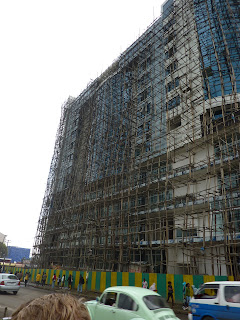Today was my first proper day at work. I got up early and caught the bus from Haramaya campus down to the health campus at Harar. The bus leaves between 0645 and 0730ish and takes around 40 minutes to reach Harar. We didn’t have time for breakfast before leaving and so Susan and I headed over the road to the coffee shop for chai and a very yummy donut-like thing for breakfast. Then at 9am we met the Dean of the medical school, Dr Tekame, who took us over to the hospital for a tour.
Haramaya uni has only recently opened a medical school, to help with the government expansion of health workers and so far only one class has graduated. The hospital only became affiliated to the university last year and so the training of staff which has now become a massive part of their life is new to everyone. The one paediatrician is, I think, called Dr Frikurta (I have been introduced to so many people and the names go in one ear and out the other). Her name apparently means love, and she does indeed seem lovely, and very glad to have an extra pair of hands which is a relief.
The paediatric department is a mass of contradictions, some bits seeming to be impressively organised while others lack basic necessities completely. The good bits are the structure for medical student training - they get two 12 week paediatric attachments in their clinical years which is almost 5 times the amount of clinical paeds I got to do as an undergraduate, and the weeks in principal are very structured. Each day begins with two hours of lectures from 0815 to 1030. Then teaching rounds and bedside teaching where cases are presented and discussed. Each student has their own patient who they clerk, and manage under supervision. Every Wednesday the students present a topic they have researched, last week it was vaccinations, this week it will be diarrhoeal disease. If (and in Africa it’s a big IF) this goes to plan I think we should churn out some very well trained students.
Other good parts are the paediatric labs, which are separate from the main labs, and appear clean, uncluttered and well organised with well labelled draws, plenty of sharps bins etc. The lab staff take as well as processing all the samples (which I think is a brilliant idea- can you imagine if that happened in the UK? No more repeating “insufficient samples” that you know fine well were not insufficient). Also there is a maternal child health unit run by a lovely midwife who seems stunningly competent at first impression, who co-ordinates antenatal care, HAART therapy for HIV + women, the prevention of mother to child transmission programme, does all the vaccinations and whacks in implanon, and coils as well!
But there are also bad bits, and they hit you between the eyes as you walk in. Harar as a whole is short of water, and the hospital is no exception. It’s dark and grimy. There are very few sinks, and half of the ones that are there don’t work. There is no hand gel and hand washing seems to be none existent. There is one squat loo for the whole ward, and no bathrooms or places to have a wash. Needless to say it stinks and there are flies everywhere. I asked Dr Frikurta, how many beds they have and she shrugged her shoulders “it doesn’t matter – if the beds are full we put them on a mattress in the corridor, or on the floor between beds”. This is the only paediatric ward for miles and miles and there is no where else for them to go. The ward is not that busy today –paeds in Ethiopia is just as seasonal as in the UK it seems. They have 2 nutrition rooms – one for babies, one for older children. Malnutrition seems to be a huge part of the workload. There is a critical care unit, which today was the most crowded of all, with around 10 beds and 4 cots in a room that’s about 5m square. In the centre of the room is the single oxygen tank which they share between those who need supplemental oxygen. There is a tetanus room (thankfully empty today)– a small dark 3 bedded room for treating those with tetanus. The size and darkness is to try and keep it quiet, as the slightest noise can provoke painful spasms in tetanus. I confessed to my guide, a young GP who is going to Addis to study radiology soon, that I had never seen a case and he assured me that I will be well versed in the diagnosis and management soon. The neonatal unit is warm and clean but with no incubators (there is one donated by UNICEF in another room but it doesn’t work). They look after preterm babies, those with neonatal asphyxia and infection, and those that have been abandoned, which is apparently common place.
After a hour or two of orientation I was sent away to return tomorrow, at which point Dr Frikurta will give me a list of early morning lectures so that we can decide which ones I should give. Having been one of the things I was most concerned about – standing up and giving a lecture for a couple of hours now seems like safe ground in comparison to ward work!
I therefore got a line taxi (by myself for the first time which is another story) back to campus and have spent the afternoon reading up on malnutrition, practising my Afan Oromo, and writing this.













